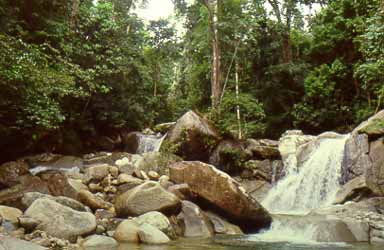


| Home| Famous Places | Museum | Historical Buildings | Temples | Caves | National Parks | Resorts |
| With its rainforest, abundant wildlife, jungle streams, waterfalls, interesting plant life, secluded beaches, panoramic rocky shoreline, bizarre rock formations and extensive network of trekking trails, Bako National Park offers visitors an excellent introduction to the rainforest and coastline of Borneo. Bako may not have an instantly recognizable star attraction, but there can be very few places in the world that pack so much natural beauty into such a limited area, all just 37 km from Kuching. Its accessibility - and its sheer range of attractions and activities - has made Bako one of the most popular parks in Sarawak.
Bako is Sarawak’s oldest national park, established in 1957. It covers an area of 2,727 hectares at the tip of the Muara Tebas peninsula. It is one of the smallest national parks in Sarawak, yet one of the most interesting, as it contains almost every type of vegetation found in Borneo. The well-maintained network of nature trails - from easy forest strolls to full-day jungle treks allows visitors to get the most out of this unique environment. Pitcher-plant can also be found at Bako National Park. It is a carnivorous plant, a meat eater. Apparently insects, particularly certain flies, find the colors of the plant attractive. The inside of the tubular shaped leaf is lined with downward pointing hairs. These hairs block an insect from climbing up the tube and escaping. The fluid in the bottom of the tube contains digestive juices that will consume the insect prey. |
 |
| Gunung Gading is home to the world’s largest flower, the Rafflesia, which can grow up to one metre in diameter. When in bloom the flower gives off a nasty smell which attracts flies and other insects. The Rafflesia has no specific season, taking nine months to mature and flowering for only 4-5 days before dying.
Gunung Gading was only opened to the public in mid-1994, after extensive environmental impact studies. Previously it was used solely as a conservation zone for the Rafflesia. The emphasis is still on conservation, and the National Parks Department have taken measures to allow visitors to view flowering Rafflesia without damaging young Rafflesia buds and other plants. There is a plankwalk close to where Rafflesia are commonly found, and if a plant is flowering deeper in the forest, the park rangers may be able to take you on a guided walk to the site. Please take care, the small brown buds that you see on the forest floor may be Rafflesia, so tread carefully and follow the park ranger’s instructions. Owing to Rafflesia’s rarity and brief flowering period, timing (and luck) are important. Although flowers generally bloom throughout the year, November, December and January can be regarded as the peak flowering season as the frequency of blooms is high. Seeing a blooming Rafflesia is certainly the highlight of a trip to Gunung Gading, but the Park and the whole Lundu area are well worth visiting anyway. The rugged mountain peaks that make up the Park provide a scenic backdrop to the nearby town of Lundu, and the nearby beaches at Pandan and Siar. Gunung Gading also has some enjoyable walks and challenging jungle treks. |
 |